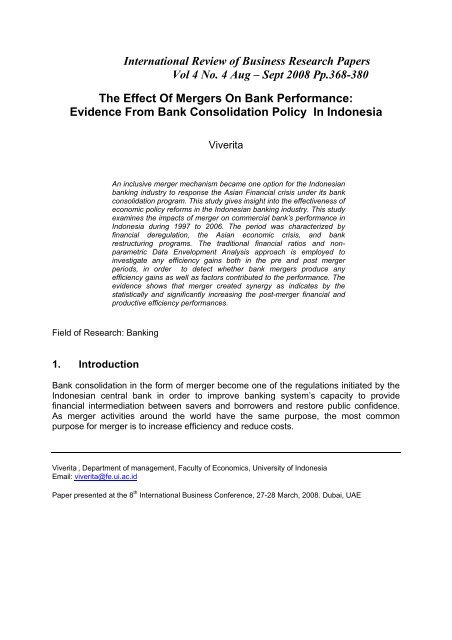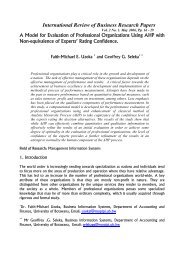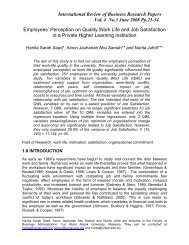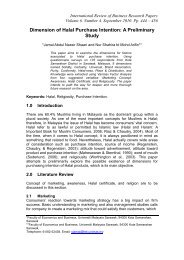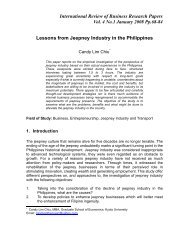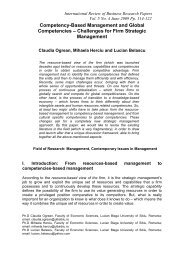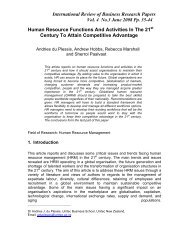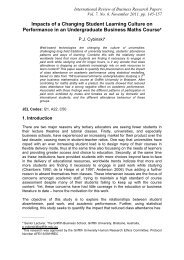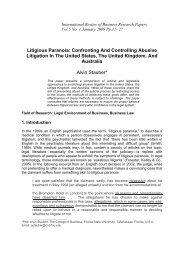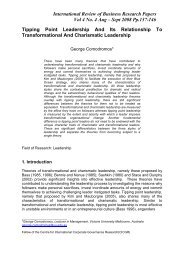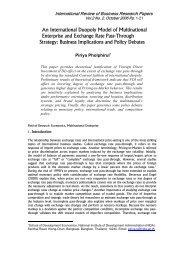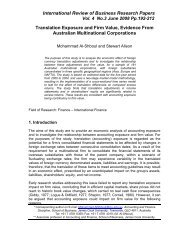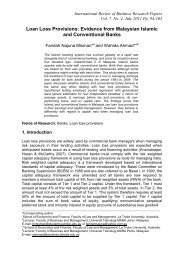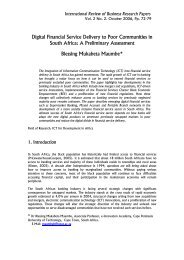International Review of Business Research Papers Vol 4 No. 4 Aug ...
International Review of Business Research Papers Vol 4 No. 4 Aug ...
International Review of Business Research Papers Vol 4 No. 4 Aug ...
Create successful ePaper yourself
Turn your PDF publications into a flip-book with our unique Google optimized e-Paper software.
Viverita 372H1:Bank performance increases after mergerBased on the whole Indonesian economic condition during the analysis periods, bankshad less freedom to control the inputs. They were also required to meet some targetslink to loan disbursement (i.e. LDR requirements) in the output side. This is conjunctionwith the decreasing <strong>of</strong> the government support and the incursion <strong>of</strong> foreign banks thusraising competition in the market. This implies banks must strengthen their lending toremain competitive. Based on these factors, we choose the output orientation for ouranalysis.3.1. Financial Indicators Measurement <strong>of</strong> Bank PerformanceSome financial ratios used in this study to evaluate bank performance pre - and postmerger is common. For example, return on asset (ROA), return on equity (ROE), nonperformingloans (NPL), loan to deposit ratio (LDR), capital adequacy ratio (CAR), andnet interest margin (NIM). Return on assets (ROA) is a comprehensive measure <strong>of</strong>overall bank performance from an accounting perspective (Sinkey, Jr., 1992, p. 43). It isa primary indicator <strong>of</strong> managerial efficiency. It indicates how capable the management <strong>of</strong>the bank has been converting the bank’s assets into net earnings. Indonesian bankingindustry, based on Bank Indonesia’s regulation <strong>No</strong>.6/23/DPNP May 31, 2004 stated thatthe banks is considered healthy if they have a minimum ROA <strong>of</strong> 1,215. ROE measuresaccounting pr<strong>of</strong>itability from the shareholder’s perspective. It is also illustrate the rate ifreturn flowing to the bank’s shareholders. It approximates the net benefit that thestockholders have received from investing their capital (Rose and Hudgins, 2006, p.151). The Indonesian central bank regulate that the minimum ROE for a healthy bank isthe same as its windows rate at the present time (currently is 8.5%). In addition, capitaladequacy ratio (CAR) indicates the capital strength <strong>of</strong> a bank. As requested by thecentral bank, banks have to maintain minimum CAR equals to 8%.The central bank’s also regulated that capital funds are consists <strong>of</strong> capital inclusive <strong>of</strong>Tier-1 and Tier-2 capital, i.e. core capital and supplementary capital respectively. Tier 1capital consists <strong>of</strong> paid-up capital and disclosed reserves such as capital reserves andprevious year after tax pr<strong>of</strong>it. The Tier-2 capital comprises <strong>of</strong> reserves from revaluatingthe fixed assets, general reserves, hybrid/quasi capital, and subordinated loans. Thecapital funds equal to 4% <strong>of</strong> the risk weighted assets (RWA) and other exposures on anongoing basis. Capital funds consist <strong>of</strong> core capital (Tier-1) and supplementary capital(Tier-2), while for RWA:RWA = (assets x risk weight) + (<strong>of</strong>f balance sheet items/contingent creditexposure x conversion factors)Based on the central bank’s regulation, all advances and loans are classified into twocategories: performing assets/loans and non-performing assets/loans (NPL). NPL is theloans that have overdue in the account and the due interest are not recovered regularly.The maximum NPL allows for a healthy bank is 5%, while net interest margin measureshow large the spread between interest revenues and interest costs that management372
Viverita 373been able to achieve by close control over earning assets and the pursuit <strong>of</strong> thecheapest sources <strong>of</strong> funding (Rose and Hudgins, 2006, p. 151). The minimum NIM for ahealthy bank is 4%. Loan-to deposit ratio (LDR) is a traditional measure <strong>of</strong> bank’sliquidity, indicates the extent to which deposits are used to meet loan request. LDR alsohas important role for the banks which is as an indicator for banks as an intermediaryinstitution to connect the excess funding holders and the users in their economicactivities. Therefore, the optimum level should be maintained, so that the necessaryliquidity needed and their function as an intermediary should be fulfilled. Total loandefines as the sum <strong>of</strong> the performing loans, non-performing loans, and deducted byallowances (provision for possible losses). Recently, the minimum LDR for commercialbanks is increase to the level <strong>of</strong> 68%, while the maximum LDR is 94, 75 %.3.2.1 Malmquist Data Envelopment AnalysisUsing the DEA methodology, one can calculate the relative efficiency <strong>of</strong> banks, whichcan be advantage the need for assigning a priori measures <strong>of</strong> relative importance <strong>of</strong> toany inputs or outputs. Therefore, one can define efficiency as full efficiency when none<strong>of</strong> its inputs or outputs can be improved without deteriorating some <strong>of</strong> its other inputs oroutputs. In addition, a bank can be considered as 100% efficient if the performance <strong>of</strong>other banks cannot be improved without worsening some <strong>of</strong> its other inputs or outputs.DEA is used as a tool to evaluate operating performance <strong>of</strong> such a DMU or anorganization. The performance is simply measured as unit (DMU) efficiency orproductivity, which is a ratio <strong>of</strong> output produced to input used in the productionprocesses. For example, partially we can measure labor efficiency as sales per number<strong>of</strong> employee. In addition, we can also measure total productivity by incorporating allpossible inputs used to produce all possible outputs <strong>of</strong> such entity.According to Bouss<strong>of</strong>iane et al. in Martin and Parker (1997; 127), DEA is a nonparametric″…linear programming method used for evaluating the efficiency <strong>of</strong> decisionmakingunits (DMUs or firms), where the presence <strong>of</strong> incommensurate inputs andoutputs makes the measurement <strong>of</strong> overall efficiency difficult”. It uses data as inputs andoutput quantities <strong>of</strong> a group <strong>of</strong> firms to construct a piece-wise frontier over the datapoints. This frontier is constructed by the solution <strong>of</strong> a sequence <strong>of</strong> linear programmingproblems, one for each firm in the sample. Efficiency measures are then calculatedrelative to this frontier, which represents an efficient technology. Hence, this method isan ideal measure for broad measurement <strong>of</strong> efficiency. Moreover, it ″allows efficiency tobe measured without having to specify either the form <strong>of</strong> production function or theweights for inputs and outputs used”. 1 Charnes et al. (1978) first used the DEA constant.It takes into account multiple inputs that are used in the production process to produceoutputs, to calculate total factor productivity. Total factor productivity (TFP) index is theratio <strong>of</strong> the weighted aggregate output to a weighted aggregate input quantity index. Thisstudy is design to apply DEA-Malmquist productivity index to measure a firm’s TFP.1 DEA is a generalized <strong>of</strong> TFP methods and non-parametric because its flexibility. That is, the nature <strong>of</strong> thefunctional form between outputs and inputs is not specified in advance (Bouss<strong>of</strong>iane et al. in Martin andParker (1997)).373
the Glorious Revolution <strong>of</strong> 1688, declined and lost most <strong>of</strong> its political clout(Nef, 1957, pp. 26 and 32). With Parliamentary supremacy established overthe Crown, legislation was passed in 1769 making the destruction <strong>of</strong> machinerypunishable by death (Mokyr, 1990, p. 257). To be sure, there was still resistanceto mechanisation. The “Luddite” riots between 1811 and 1816 were partly amanifestation <strong>of</strong> the fear <strong>of</strong> technological change among workers as Parliamentrevoked a 1551 law prohibiting the use <strong>of</strong> gig mills in the wool-finishing trade.The British government however took an increasingly stern view on groupsattempting to halt technological progress and deployed 12,000 men against therioters (Mantoux, 2006, p. 403-8). The sentiment <strong>of</strong> the government towardsthe destruction <strong>of</strong> machinery was explained by a resolution passed after theLancashire riots <strong>of</strong> 1779, stating that: “The sole cause <strong>of</strong> great riots was thenew machines employed in cotton manufacture; the country notwithstandinghas greatly benefited from their erection [and] destroying them in this countrywould only be the means <strong>of</strong> transferring them to another [. . . ] to the detriment<strong>of</strong> the trade <strong>of</strong> Britain” (cited in Mantoux, 2006, p. 403).There are at least two possible explanations for the shift in attitudes towardstechnological progress. First, after Parliamentary supremacy was establishedover the Crown, the property owning classes became politically dominant inBritain (<strong>No</strong>rth and Weingast, 1989). Because the diffusion <strong>of</strong> various manufacturingtechnologies did not impose a risk to the value <strong>of</strong> their assets, and someproperty owners stood to benefit from the export <strong>of</strong> manufactured goods, theartisans simply did not have the political power to repress them. Second, inventors,consumers and unskilled factory workers largely benefited from mechanisation(Mokyr, 1990, p. 256 and 258). It has even been argued that, despitethe employment concerns over mechanisation, unskilled workers have been thegreatest beneficiaries <strong>of</strong> the Industrial Revolution (Clark, 2008). 7 While there7 Various estimations <strong>of</strong> the living standards <strong>of</strong> workers in Britain during the industrialisationexist in the literature. For example, Clark (2008) finds that real wages over the period 1760 to1860 rose faster than GDP per capita. Further evidence provided by Lindert and Williamson(1983) even suggests that real wages nearly doubled between 1820 and 1850. Feinstein (1998),on the other hand, finds a much more moderate increase, with average working-class livingstandards improving by less than 15 percent between 1770 and 1870. Finally, Allen (2009a)finds that over the first half <strong>of</strong> the nineteenth century, the real wage stagnated while output perworker expanded. After the mid nineteenth century, however, real wages began to grow in linewith productivity. While this implies that capital owners were the greatest beneficiaries <strong>of</strong> theIndustrial Revolution, there is at the same time consensus that average living standards largelyimproved.7
Viverita 378Hill/Irwin, New York.Barro, Robert J. 2001. “Economic Growth in East Asia Before and After the FinancialCrisis”, National Bureau <strong>of</strong> Economic <strong>Research</strong> Working Paper 8830. http://www.Nber.org/paper/w8330Canhoto, A., Dermine, J. 2003, "A note on banking efficiency in Portugal: new vs. old.banks", Journal <strong>of</strong> Banking and Finance, <strong>Vol</strong>. 27 <strong>No</strong>.11, pp.2087-98.Charnes, A. et al. 1978. “Measuring efficiency <strong>of</strong> decision making units”, EuropeanJournal <strong>of</strong> Operational <strong>Research</strong>, 2, pp. 429-44Coelli, T.J et al. 1998. An Introduction to efficiency and productivity analysis. KluwerAcademic Publishers Boston, Dodrecht, London.Cooper, William W., Lawrence M. Seiford, and Kaoru Tone. 2007. Data EnvelopmentAnalysis: Comprehensive Text with Models, Applications, References and DEA –Solver S<strong>of</strong>tware. Second Edition. Springer.Damodaran, Aswath, 2006, Damodaran on Valuation: Security Analysis for Investmentand Corporate Finance, 2 nd ed, John Wiley & Sons, Inc., New Jersey.DeLong, Gayle (2001). “Does Long-Term Performance <strong>of</strong> Mergers Match Marketexpectation? Evidence from the US Banking Industry”, Financial Management,<strong>Vol</strong> 32 <strong>No</strong>. 2, pp.5-25.Fare, Rolf; Grosskopf, Shawna and Margaritis, Dimitri. 2001. “Productivity Trends inAustralian and New Zealand Manufacturing”, The Australian Journal <strong>of</strong> Economic<strong>Review</strong>, 34(2): 125-34.Fare, Rolf and Grosskopf, Shawna. 1994. “Measuring Productivity: A Comment”,<strong>International</strong> Journal <strong>of</strong> Operation & Production Management, <strong>Vol</strong> 14, <strong>No</strong> 9, pp.83-88.Fare, Rolf, Grosskopf, Shawna, and Lee, Wen-Fu. 1995. “Productivity in TaiwaneseManufacturing Industries”, Applied Economics, <strong>Vol</strong> 27, pp. 259-65.Fare, Rolf; Grosskopf, Shawna and Margaritis, Dimitri. 2001. “Productivity Trends inAustralian and New Zealand Manufacturing”, The Australian Journal <strong>of</strong>Economic <strong>Review</strong>, <strong>Vol</strong> 34 <strong>No</strong> 2, pp: 125-34.Gjirja, Matilda, 2003. “Assessing the Efficiency Effects <strong>of</strong> Bank Mergers in Sweden Apanel- based Stochastic Frontier Analysis”, Working Paper Department <strong>of</strong>Economics Göteborg University, SwedenHadad, Muliaman D., Santoso, Wimboh, Ilyas, Dhaniel & Mardanugraha, Eugenia, 2003.378
Viverita 379“Analisis Efisiensi Industri Perbankan Indonesia”, Working Paper,Bank Indonesia(http://www.bi.go.id/NR/rdonlyres/C2FC92CC-F93B-4CFF-905E-2007E55FE7D2/1400/PenggmetodeparametrikDEA.pdf)Havrylchyk, O.,2006. "Efficiency <strong>of</strong> the Polish Banking Industry: Foreign versusDomestic Banks."Journal <strong>of</strong> Banking and Finance 30(7): 1975-1996.Houston, J.F, C. James, and R.M Ryngaert, 2001. “Where Do Merger Gains ComeFrom? Bank Merger from the Perspective <strong>of</strong> Insiders and Outsiders”, Journal <strong>of</strong>Financial Economics 60,pp.285-32.Jensen, M.C. and R.S Ruback (1983). “The Market for Corporate Control: The ScientificEvidence”, Journal <strong>of</strong> Financial Economics, <strong>Vol</strong> 11 pp. 5-50.Koetter, Michael, 2005. “Evaluating the German Bank Merger Wave”, Utrecht School <strong>of</strong>Economics & Tjalling C. Koopmans <strong>Research</strong> Institute, Utrecht, Netherlands.Kwan, Simon.,2004. “Banking Consolidation” FRBSF Economic Letter <strong>No</strong> 2004-FederalReserve Bank <strong>of</strong> San Fransisco.(http://www.frbsf.org/publications/economics/letter/2004/el2004-15.pdf)Levine, David M., Stephan, David, Krehbiel, Timothy C. & Berenson, Mark L., 2005.Statistics For Managers Using Micros<strong>of</strong>t Excel. 4 th ed. Pearson Prentice Hall,New Jersey.Lind, Douglas A., Marchal, William G. & Wathen, Samuel A., 2005, StatisticalTechniques in <strong>Business</strong> & Economics, 12 th edn, McGraw-Hill/Irwin, New York.Rose, Peter S. & Hudgins, Sylvia C., 2006. Bank Management & Financial Services, 6 thed.McGraw-Hill, New York.Samosir, Agunan P., 2003. “Analisis Kinerja Bank Mandiri setelah Merger dan Sebagaibank Rekapitalisasi”, Kajian Ekonomi dan Keuangan, <strong>Vol</strong>. 7, no. 1, Jakarta.Sekaran, Uma, 2003. <strong>Research</strong> Methods for <strong>Business</strong>: a Skill Building Approach, 4 th ed,John Wiley & Sons, Inc., New York.Sinkey, Jr., Joseph F., 1992. Commercial Bank Financial Management: In the Financial-Service Industry, 4 th Ed, Macmillan Publishing Company, Ontario.Soemonagoro, Koeswardojo, 2006. “Challenging the Performance <strong>of</strong> a RestructuredIndonesian Bank: A Case Study <strong>of</strong> Bank Mandiri’s merger and recapitalization”.unpublished thesis, Swiss German University, Indonesia.van Rooij, M.C.J (1997). “Bank Mergers, Banking Efficiency, and Economies <strong>of</strong> Scaleand Scope. A <strong>Review</strong> <strong>of</strong> Empirical Literature”, <strong>Research</strong> Memorandum WO&E nr379
Viverita 380511/9726. The Netherlandsche Bank NV.Econometric <strong>Research</strong> and SpecialStudies Department.Vasudevan, A., 2004. “Bank M&A: Stability and Synergy”, viewed 28 March 2007,.Yener, Altunbas & Ibáñez, David Marqués, 2004.” Mergers and acquisitions and bankperformance in Europe: the role <strong>of</strong> strategic similarities”, Working Paper Series398, European Central Bank.380


